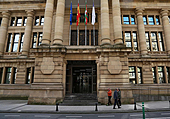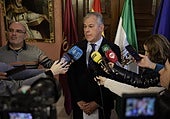The Holy Week in Valladolid and the sounds of silence
Today's programme includes only two processions, which share the main sign of identity of Holy Week in Valladolid: silence
FRANCISCO CANTALAPIEDRA
Martes, 19 de abril 2011, 13:56
Today's programme includes only two processions, which share the main sign of identity of Holy Week in Valladolid: silence. The first starts at nightfall and ends after ten o'clock; the second starts when the other has returned to its church. The first carries the majestic Madonna of Las Angustias, which is taken along the streets to meet up with her Son on calle de La Amargura, on this occasion on Plaza de Santa Cruz. The statue is the magnificent work of Juan de Juni, whose French or Italian origin is not clear, but who left behind figures such as the one carried in this procession. The statue's face of sorrow is said to have been inspired by the premature death of the sculptor's own daughter. The procession is completed with the statue of Cristo Camino del Calvario (Christ on the Road to Calvary), which was made in 2009.
The second procession of the day is La peregrinación de la Promesa (The Pilgrimage of the Promise), which reaches its culminating moment on the outskirts of the city, opposite the church of La Pilarica, in an area that is split in two by the railway. The church façade is located right next to the level crossing. The act of promising silence (which is the purpose of the procession) is sometimes affected by the vibrations caused by passing trains. Overweight cathedral. As there are no processions to see until just after eight o'clock in the evening, you can enjoy a walk around the area near the cathedral, a surprising building that is missing a tower. Although there are all kinds of legends about the cathedral, which was designed by Juan de Herrera, the unbuilt part is the result of a shortage of finance rather than will. Its interior boasts an altarpiece by Juan de Juni and a monstrance by Juan de Arfe.
The only remaining tower bears a huge statue of Christ, which does not fit in with the cathedral itself or with anything related to its past. It is a stone sculpture of no particular value representing the Sacred Heart of Jesus and it was put there in 1923. It is not worth any great study except for the 'extra weight' it adds to such a sober building. To Santa Cruz. You must be in Plaza de Santa Cruz at half past eight to see the procession of El Encuentro (The Encounter), which arrives there shortly afterwards. Before you get there, you can enjoy a coffee in Avec Moi or La Uni, where Carlitos will serve you anything you ask for with a smile. You can also buy some sweets for the wait (not sunflower seeds, please) in Dulce Manía. The best place for seeing this procession is opposite the Santa Cruz Mansion, which is today home to the vice-chancellor's office. At one time, the cellars of the building contained a good number of Holy Week sculptures, many of which are now carried in the processions. If the crowds allow, take a look at the chapel to the right of the main door, which is where the wonderful Cristo de la Luz (Christ of the Light) is kept all year round. If the night is cold, you can warm up with a consommé soup in Casa de Galicia, where a band of Galician pipers will greet the statue as it sets off on the procession. Band and lineage.
After the procession on Plaza Santa Cruz, I suggest you set off before it towards the church of Las Angustias, where the main statue finally ends up. As those carrying the statue on their shoulders supposedly walk faster than the brothers, they can wander off track a little and buy a warm baguette at a reasonable price in Caprichos y Delicias, on calle de Ruiz Hernández. If you manage to reach the church, you will see that it is home to the brotherhood of the Madonna of Las Angustias, which dates from 1536, as shown by a papal bull that awarded privileges to the members who did charity work and penitence. Regardless of whether you manage to get inside, remember that the church was built thanks to the generous donations by the merchant Martín Sánchez de Aranzamendi, whose condition was that people who did not belong to his lineage could not be buried inside it. If you fancy something to eat or drink, I suggest a glass of wine and a tapa in Capilla Sixtina, 100 metres from the church, where the host is Chuchi Rodríguez, Vice-chairman of the Board of Brotherhoods. The promise of silence.
The last procession of the day sets off at half past ten at night from the convent of Santa Isabel, which has interesting sculptures by Juni, Gregorio Fernández and the Berruguete school. The brothers taking part in the procession carry the statue of El Señor Atado a la Columna (Our Lord Tied to the Column) from there to the church of La Pilarica (a good two kilometres away). The statue is by Fernández and comprises a statue of Christ being whipped whose back and eyes make an impression on those who see it. Plaza de Rafael Cano is the place where this statue and that of the smaller and more modest Madonna of El Pilar meet. Before going home, the brothers remove their hoods and promise not to speak at all on Holy Friday. You can finish off with a drink in the cafeteria Compás, where the owner, Toño, will enlighten you about the qualities of the many brands of gin at the back of the bar.


